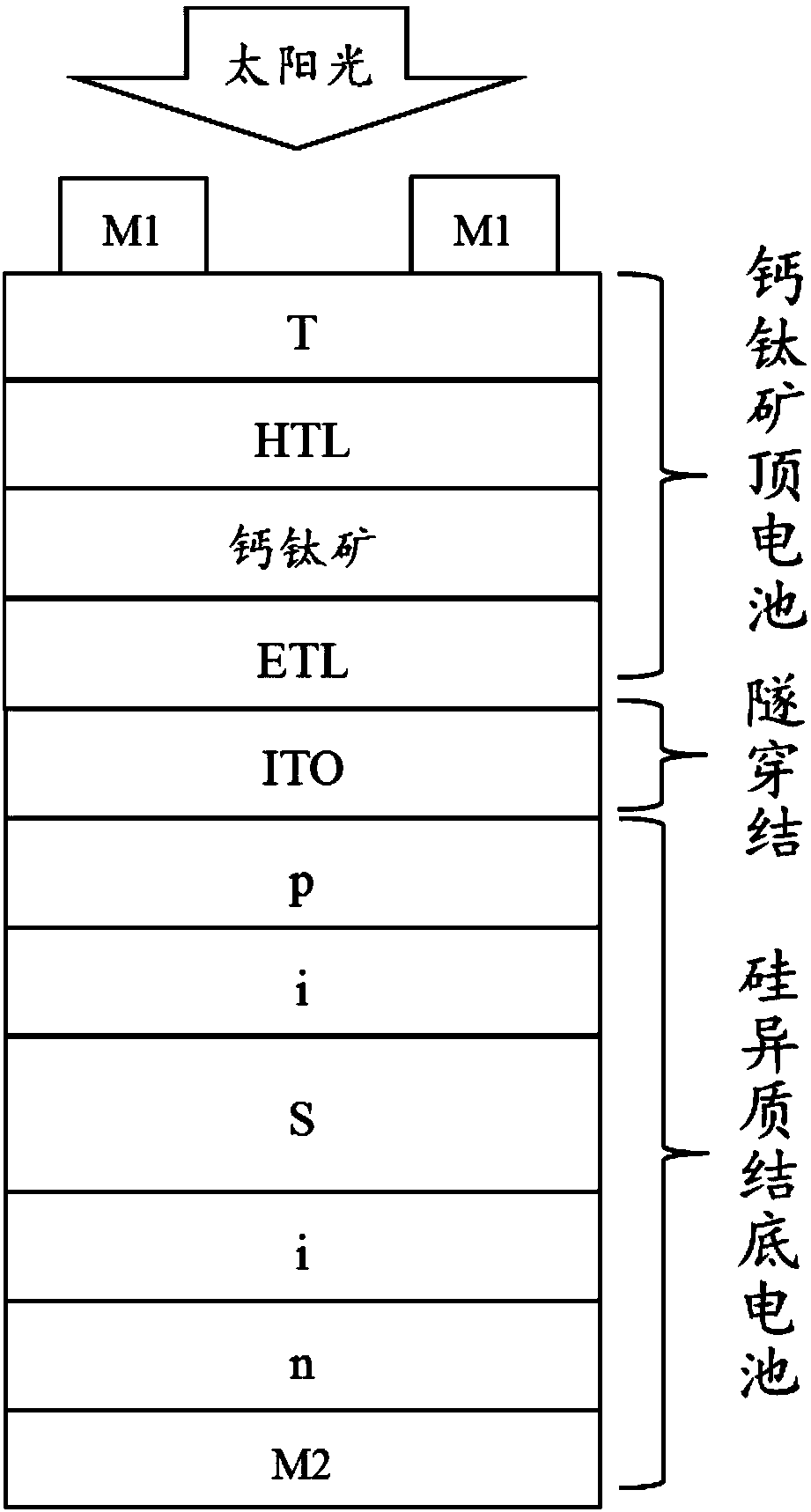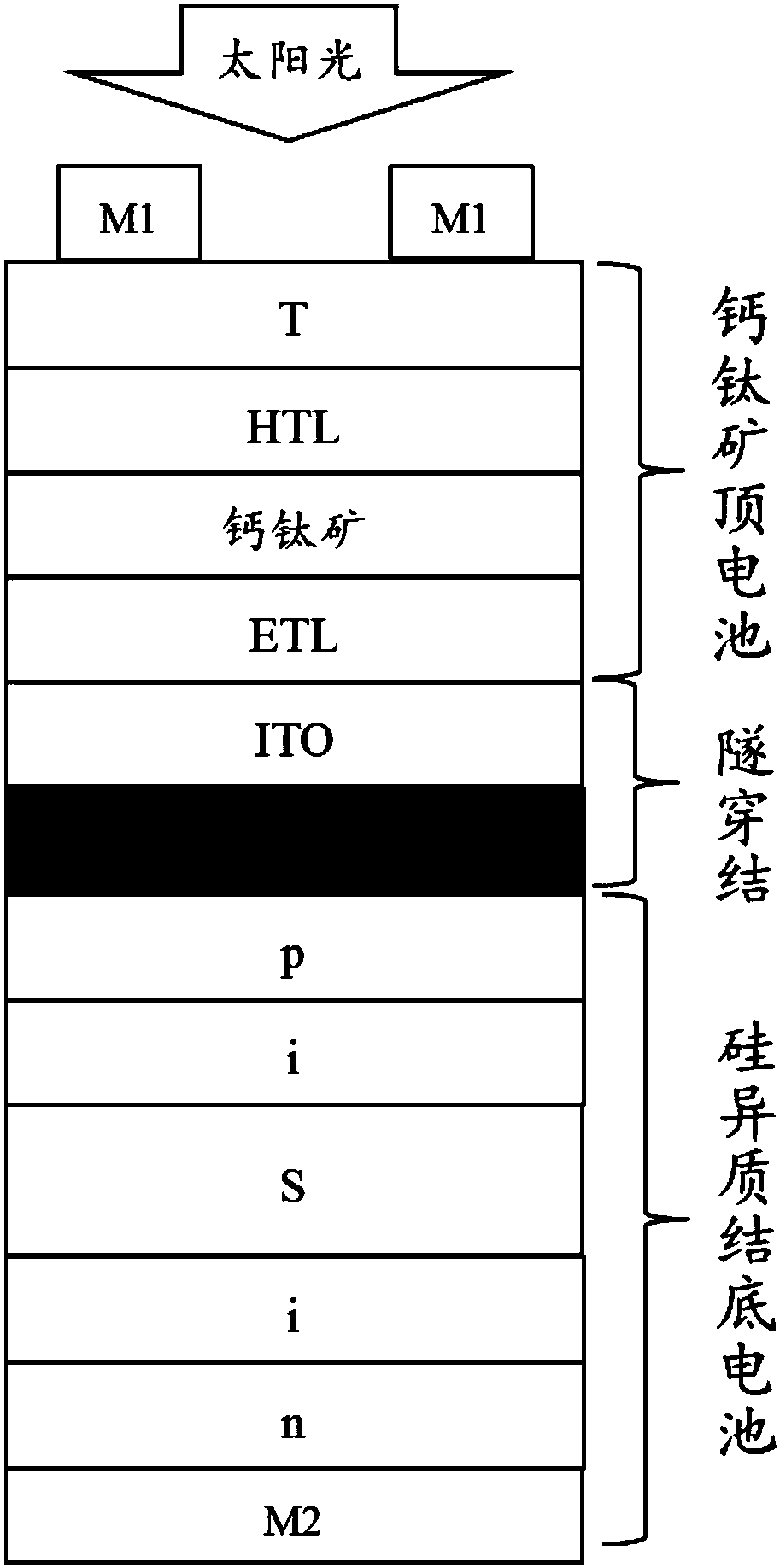Structure design of tunnel junction in Perovskite/silicon heterojunction lamination solar battery
A silicon heterojunction and stacked solar technology, applied in the field of solar cells, can solve problems such as the influence of open circuit voltage, achieve the effects of hole recombination improvement, tunneling probability improvement, and avoiding a large amount of accumulation
- Summary
- Abstract
- Description
- Claims
- Application Information
AI Technical Summary
Problems solved by technology
Method used
Image
Examples
Embodiment 1
[0019] This embodiment is a structure of a traditional perovskite / silicon heterojunction stacked solar cell, such as figure 1 As shown, it includes from top to bottom: metal grid line electrode M1, transparent electrode T, perovskite top cell hole transport material HTL, perovskite absorption layer, top cell electron transport material ETL, tunnel junction ITO, silicon The hole selection layer p of the heterojunction bottom cell, the passivation layer i, the substrate S, the electron selection layer n and the metal back electrode M2.
[0020] Wherein the crystalline silicon layer S is n-type polished single crystal silicon.
[0021] The silicon heterojunction solar cell of this embodiment is prepared by the following method:
[0022] 1. Place the polished Cz silicon wafer substrate with N-type crystal orientation in a PECVD system with high vacuum, and deposit a layer of intrinsic amorphous silicon passivation layer i on the front and back surfaces of the silicon wafer.
[...
Embodiment 2
[0030] This embodiment is a structure of a perovskite / silicon heterojunction stacked solar cell provided by the present invention, such as figure 2 As shown, it includes from top to bottom: metal grid line electrode M1, transparent electrode T, perovskite top cell hole transport material HTL, perovskite absorption layer, top cell electron transport material ETL, tunnel junction ITO+TRL , silicon heterojunction bottom cell hole selection layer p, passivation layer i, substrate S, passivation layer i, electron selection layer n and metal back electrode M2.
[0031] The TRL is n-μc-Si:H, the thickness is 10nm, the gap is 1.7eV, the conductivity is 2s / cm, and the long-wavelength transmittance is 81%.
[0032] The crystalline silicon layer S is n-type polished single crystal silicon.
[0033] The silicon heterojunction solar cell of this embodiment is prepared by the following method:
[0034] 1. Place the polished Cz silicon wafer substrate with N-type crystal orientation in a...
Embodiment 3
[0043] This embodiment is a structure of a perovskite / silicon heterojunction stacked solar cell provided by the present invention, such as figure 2 Shown, concrete structure is with embodiment 2, is omitted here.
[0044] Where TRL is p-μc-Si:H / n-μc-Si:H, and the thicknesses are 0.5nm and 10nm, respectively.
[0045] The crystalline silicon layer S is n-type polished single crystal silicon.
[0046] The subsequent process of the silicon heterojunction solar cell in this embodiment is the same as that in Embodiment 2, which is omitted here.
[0047] The p / n-μc Si:H is applied to the preparation process of the perovskite / silicon heterojunction tandem solar cell, and the opening voltage of the perovskite / silicon heterojunction solar cell is 1.71V.
PUM
 Login to View More
Login to View More Abstract
Description
Claims
Application Information
 Login to View More
Login to View More - R&D
- Intellectual Property
- Life Sciences
- Materials
- Tech Scout
- Unparalleled Data Quality
- Higher Quality Content
- 60% Fewer Hallucinations
Browse by: Latest US Patents, China's latest patents, Technical Efficacy Thesaurus, Application Domain, Technology Topic, Popular Technical Reports.
© 2025 PatSnap. All rights reserved.Legal|Privacy policy|Modern Slavery Act Transparency Statement|Sitemap|About US| Contact US: help@patsnap.com


